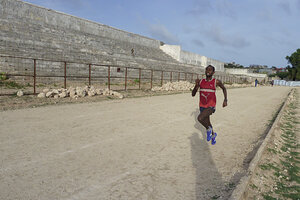Training for the Olympics in the shadow of war
To get to the London Games, Somalian runner Mohamed Hassan Mohamed has had to survive warring militias, Islamic insurgents, and the occasional stray bullet along his workout route.

Mohamed Hassan Mohamed, a Somalian Olympic runner, trains in Mogadishu’s bullet-ridden Konis Stadium, which a year ago was a base for Islamist militants. Mr. Mohamed once had to flee to Yemen to avoid civil war.
Abdiaziz Abdinor Ibrahim
Mogadishu, Somalia
A few years ago, while training to be a competitive runner, Mohamed Hassan Mohamed had to deal with something most athletes never confront: A neighborhood acquaintance was beheaded by members of Al Shabab militia group, and they were threatening his friends – and him – as well.
So the young man, fearing for his life, fled Somalia and embarked on a perilous journey to Yemen. For three days, he survived the choppy waters of the Gulf of Aden in a small boat crammed with refugees and nothing to eat or drink – convinced, at times, the vessel was going to capsize. He ended up staying in Yemen for two years, getting whatever work he could – mainly as a $100-a-month office cleaner.
Today, back in a more stable but still dangerous Mogadishu, he is training again, this time as Somalia's 1,500-meter entrant in the Olympic Games. When Mr. Mohamed walks into London's Olympic stadium later this month, it will no doubt mark one of the more harrowing paths to the Games of any of the 10,500 other athletes.
Even today, training in Somalia's capital city has its perils. One of the world's most chronically unstable countries, Somalia has been cleaved by violence for more than two decades, first from warring clans and warlords and more recently from Al Shabab Islamic insurgents trying to oust the transitional government.
While the Al Qaeda-linked insurgents withdrew from Mogadishu in August 2011, they continue to control large sections of the countryside and foment violence in the capital city. In April, a suicide bombing at an outdoor theater killed several people – including the prominent head of Somalia's Olympic committee.
In their training, the athletes occasionally run along a main thoroughfare in Mogadishu – once called the "road of death" because it served as the dividing line between government and Al Shabab forces – past cordons of armored troop carriers and security checkpoints. Assassinations and kidnappings remain common. One reason the Somalia Olympic committee waited so long, until well into July, to choose its two Olympic entrants was to avoid making them targets.
Still, training is a lot safer now than it used to be. Mohamed spends part of his day working out at Konis Stadium, Mogadishu's national soccer venue. A year ago, it was a redoubt and rebel training camp for Al Shabab militants. Pockmarks from bullets and crumbled concrete seats testify to the stadium's earlier role as a theater of war rather than of sport.
At one point during the fighting, Islamic militants had taken over Mohamed's neighborhood, and some of his friends were joining Al Shabab forces. Government troops controlled other parts of the city and set up roadblocks.
"I lost my freedom to live and to exercise," he says. "You couldn't run. You couldn't wear your sports dress. I became frustrated."
Today he feels more secure, and some people even recognize the Olympians when they are training in public. "When I run through Mogadishu streets, the people applaud and I feel strong," he says.
Mohamed, age 22, is one of two Somalis chosen to compete at the London Games. The other is female runner Zam Zam Mahmoud Farah. Both are being invited as "wild cards." Under Olympic rules, countries that fail to produce athletes who meet official qualifying times are still allowed to send two competitors.
The Somali athletes don't have the benefit of modern workout facilities, lavish expense accounts, dietary experts, or a retinue of personal trainers. They live in a renovated classroom in a dusty part of town full of abandoned buildings. Their rooms are spare: no telephones, Internet service, or TVs. Mosquito nets hang over the beds. Mohamed rises at 5 every morning to begin his workouts, then follows up with a second run in the evening.
As a youth, he had wanted to be an engineer. Now, after his quest for Olympic immortality, he has a new focus in life: to become a sports coach or administrator. But first there's London to conquer. "My life is good," he says.
Sunday:
Gladys Tejeda: Getting to the Olympics on borrowed shoes
Monday:
Hiroshi Hoketsu: A Japanese Olympian defies the age barrier
Kayla Harrison: An American Olympian rebuilds a life through judo and friends
Tuesday:
Mohamed Hassan Mohamed: Training for the Olympics in the shadow of war
Behdad Salimi: An Iranian Olympian carries the weight of a nation
Wednesday:
Yamilé Aldama: A British track star jumps through a tough decade
Geeta Phogat: How an Indian wrestler defied gender taboos
Thursday:
Tahmina Kohistani: Afghan sprinter tries to beat the clock - and pollution

